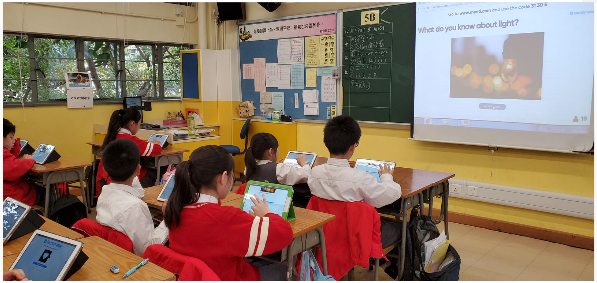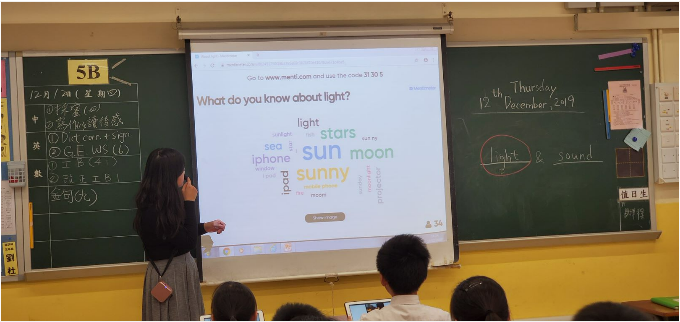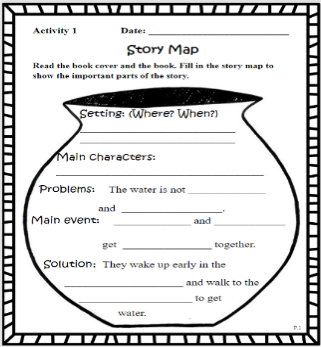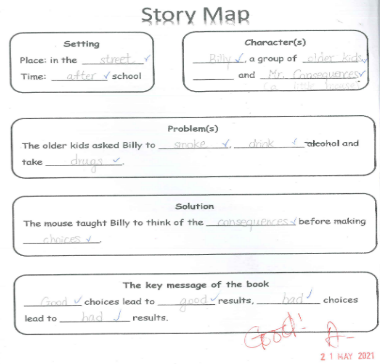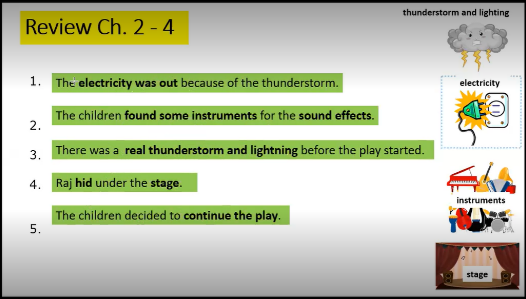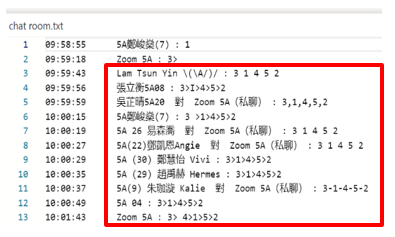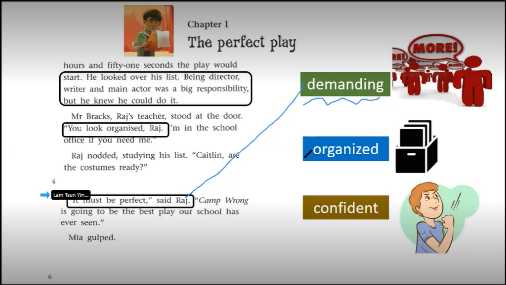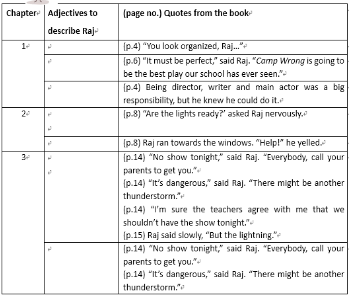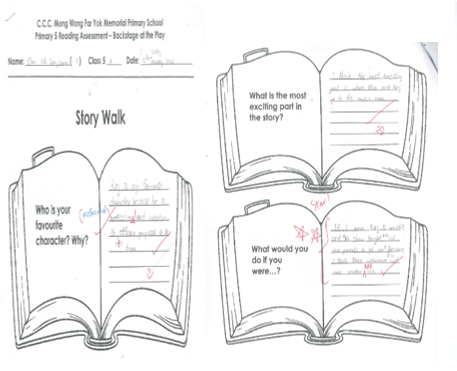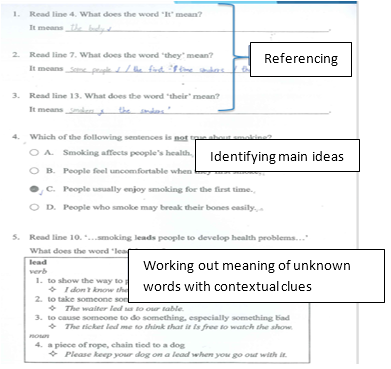Promoting Reading across the Curriculum in Key Stage 2 to help students connect their learning experiences
Background
Building on the previous years' experience in promoting reading, teachers of CCC Mong Wong Far Yok Memorial Primary School decided to make use of the extra funding provided by the Grant Scheme on Promoting Effective English Language Learning in Primary Schools (PEEGS) to implement a "Reading across the Curriculum" (RaC) project. The RaC project aimed at elevating students' learning, in particular, deepening their knowledge in different subject areas, developing positive values and attitudes that support independent learning and promoting effective English language learning in Key Stage 2. Through holistic curriculum mapping of the school English Language and General Studies curricula, teachers taught students how to read a variety of fiction and non-fiction books which were closely aligned with the themes of the two subjects. It is hoped that students' learning experiences from different subjects could be better connected and their reading interest could be nurtured through reading a variety of books. All the cross-curricular modules were implemented using a blended learning approach due to the suspension of face-to-face classes. Synchronous and asynchronous learning were strategically adopted to maximise students' learning time and enhance teaching effectiveness.
Level(s)
P4-6
Strategies used
Mapping the General Studies and English Language curricula to identify common themes in the RaC project
Teachers from the English and General Studies Departments collaborated to identify common themes with a view to establishing meaningful links between concepts and ideas acquired in the two subjects and providing students with opportunities to demonstrate their ability to use the knowledge gained from both subjects to conduct project work and share reading experiences through different means.Explicitly teaching students Learning to Read skills to prepare them for Reading to Learn
With a variety of theme-related books chosen, including fiction and non-fiction books, English Language teachers taught reading skills explicitly in class to ensure that students could understand and analyse the target language items, text features and text types. Worksheets were designed for guiding students through their reading of multidisciplinary texts. Students were also assigned to read other books of the common themes chosen outside class time to sustain their interest in the themes and motivate them to read to learn through independent reading.Engaging students in sharing their reading experiences through a variety of tasks and modes of assessment
Instead of assigning students to write book reports or respond to questions in worksheets, General Studies and English Language teachers worked together to design meaningful activities such as making videos, drawing posters, working out do-it-yourself models and doing research for students to share their reading experiences. Teachers used different ways to sustain students' learning interest and empower them to learn independently, especially during the suspension of the face-to-face classes. Formative assessments in class and meaningful homework were assigned to students in order to monitor closely students' learning progress.Infusing positive values and attitudes into different RaC modules
With the use of a combination of fiction books and informational books on selected topics, a lot of discussion points about value judgement were generated as what students had learnt from the books could be linked to their life experiences. Thus, reading a variety of books could give students a lot of food for thought and it created a chance for teachers to promote values education through discussing life events with them.
What happened
English Language teachers implemented RaC through the Reading Workshops with input from General Studies teachers. Fiction and non-fiction books were chosen based on the common themes identified by both English Language and General Studies teachers through curriculum mapping. An RaC Team, comprising six English Language teachers, was formed to plan and implement the project by four stages.
Stage 1: Curriculum mapping and book selection
Teachers aimed to provide broad and balanced reading experiences to students. Similar topics from English Language and General Studies were identified and grouped into two themes. Students read four books in the Reading Workshops per year, including one fiction and one non-fiction book for each theme. For example, P4 students read a story about a little girl in face of water shortage in Africa and they read a non-fiction book about the sources of water and water usage. Students were taught to make a water filter as the final task to apply the knowledge and skills gained from both subjects. Students learnt to save water, protect the environment and eat healthily in the RaC modules and it somehow brought changes to their present practices and encouraged them to look for areas for improvement in their daily life.
Levels |
Common themes |
Fiction |
Non-fiction |
Final tasks |
P4 |
Water |
“The Water Princess” |
“The Question of Water” |
Make a water filter |
|
Healthy eating |
“The Queen’s New Chef” |
“My Body Needs Food” |
Make plans for a healthy family meal |
P5 |
Light |
“Backstage at the School Play” |
“Light” |
Conduct an experiment |
|
Healthy living styles |
“Making Good Choices” |
“Lungs” |
Create a poster to promote healthy living style |
P6 |
Helpers in daily life |
“Rocky the Robot Helps Out” |
“Simple Machines” |
Make a video to introduce a home robot |
|
Environmental protection |
“The King of Waste” |
“How Can We Reduce Household Waste?” |
---- |
Common themes were identified from the two subjects and both fiction and non-fiction books were matched with corresponding themes.
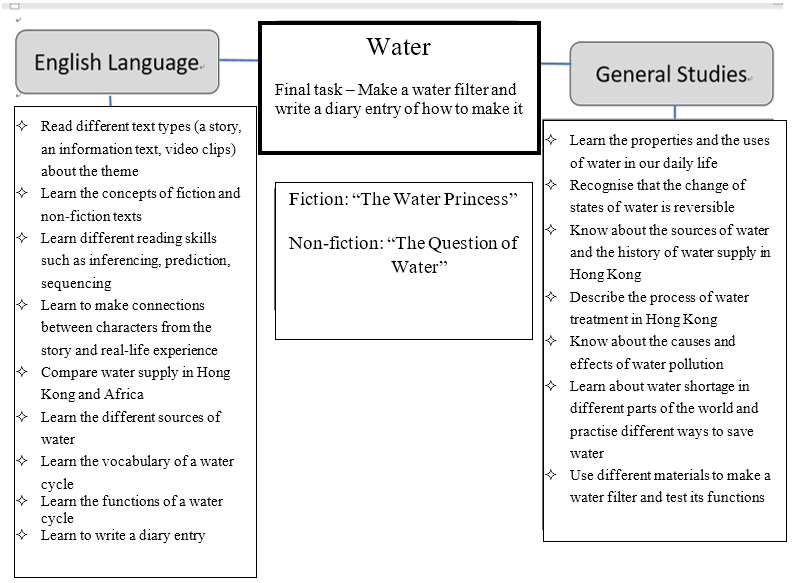
An example of a P4 curriculum map showing how the final task enabled students to enrich and consolidate their learning in both subjects
Stage 2: Explicit teaching of reading skills
Reading skills were explicitly taught in different stages of the reading lessons in the blended learning mode. Some activities were completed by students in their own time and place, while others were conducted by teachers in online or face-to-face lessons. All the reading tasks developed were collated in the reading booklets.
Explicit teaching of reading skills was carried out using different activities and tasks in the lessons. It helped students comprehend the whole text through:
- making predictions on what they would read;
- checking their understanding of the plot development and sequence of events in a story;
- having a deeper understanding of its theme and characters;
- connecting events in the text to prior knowledge or experience;
- working out meaning of unfamiliar words;
- clarifying parts of the text from time to time;
- making inferences; and
- summarising the meaning of the whole text.
Making predictions |
Students shared keywords on what they knew about "light" - the concepts they learnt in General Studies lessons. |
Summarising
Students summarised details about the whole story using story maps. |
|
Sequencing |
Students typed their answers in the chat room in response to the teacher's questions. |
Inferencing |
Students were assigned to do a similar exercise at home for consolidation. |
Stage 3: Designing meaningful post-reading activities for students to respond to texts
Developing students' positive values and attitudes and critical thinking skills
An example in P4
P4 students learnt about the types and functions of nutrients in General Studies lessons. They identified nutrients in different kinds of food and learnt how to eat healthily. They were taught to read the non-fiction reader, "My Body Needs Food", to learn some of the content subject concepts in English Language and enrich their knowledge and vocabulary on the topic. The fiction book, "The Queen's New Chef", was used and students were required to critically analyse the characters' eating habits. By the end of the module, students were asked to do a project on "Healthy eating". They had to design a healthy and nutritious meal for their family with a limited budget. Due to the pandemic, students had to search for the food items and prices online. They applied their I.T. skills to do information search. They also needed to draw upon their Mathematics knowledge to calculate the serving size and use pie charts to show the proportion of food types.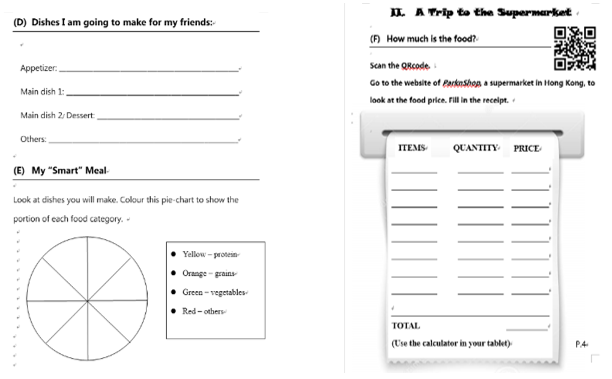
Through mapping the curricula across Key Learning Areas, teachers helped students connect
the knowledge gained from different content subjects in the RaC project. This RaC project
could also provide a platform for cross-curricular collaboration among different departments.An example in P5
In the General Studies module, "Love Your Body", students learnt about the effects of smoking on the respiratory system and how drugs and alcohol harm human's health. To match with what students learnt in the content subject, English Language teachers chose the non-fiction book, "Lungs", and fiction book, "Making Good Choices". At the end of the RaC module, students were required to design a poster to remind people to refrain from bad habits. Students were given the choice between drawing a poster and using the app, Adobe Spark, to create a poster during the suspension of face-to-face classes. Students learnt to be responsible for their actions and decisions as well as care for others.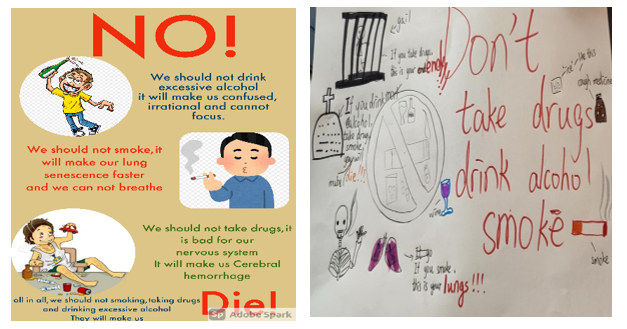
Enriching students' language skills, grammar knowledge and thinking skills
In the post-reading stage, students were often asked to share their views, learning and feelings about different topics. Thus, different activities and tasks were designed with the purposes of enriching students' content subject vocabulary, teaching more relevant language patterns and grammar knowledge and developing their thinking skills through using "problem and solution" and "cause and effect" to organise information so that they could have richer language to respond to the texts.Tasks for enriching students' content subject vocabulary
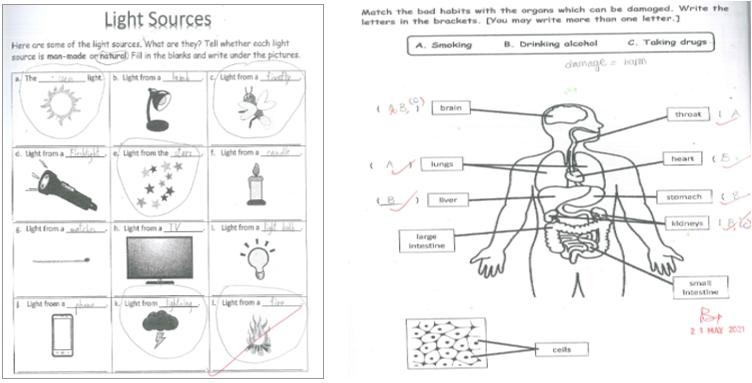
Students learnt about the sources of light and names of different organs in English Language lessons
after they had learnt these concepts in General Studies.Tasks for developing students' thinking skills to facilitate in-depth analysis of the topics
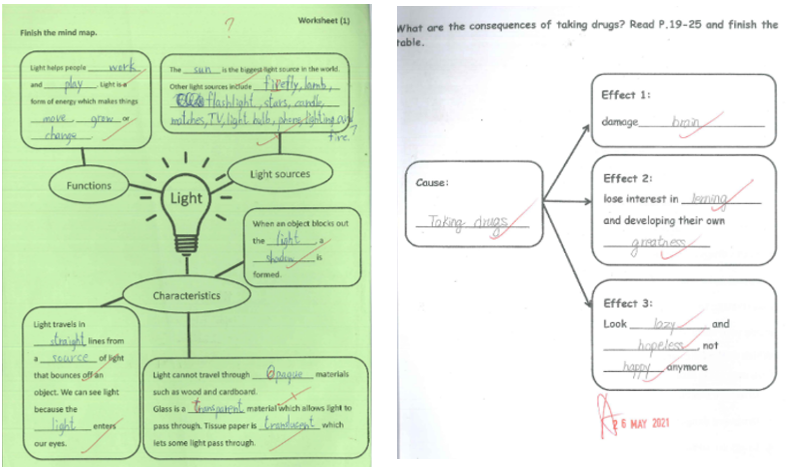
Different graphic organisers were used to help students summarise the importance of light in our
daily life and the causes and consequences of taking drugs.Tasks for teaching grammar and relevant sentence patterns
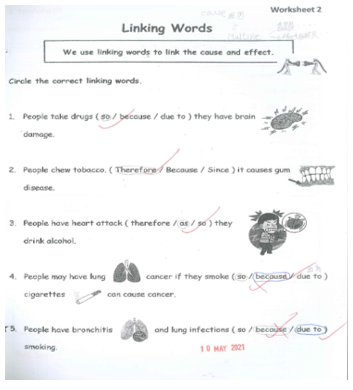
Students learnt to use connectives to talk about the
“causes and consequences” of taking drugs.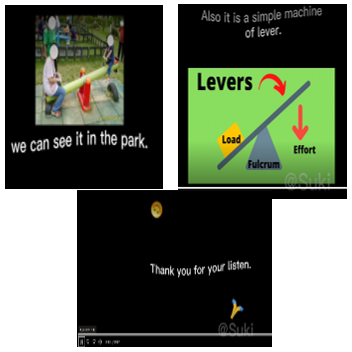
Students made use of the target grammar structures learnt
in the English Language lessons to explain the lever system
and presented the information using PowerPoint.
Engaging students in carrying out self-directed learning tasks to develop them into independent learners
Students were given more opportunities to work on independent inquiry tasks after reading some non-fiction books and other learning resources suggested by teachers. They were expected to integrate and apply knowledge and skills across different Key Learning Areas in different learning tasks.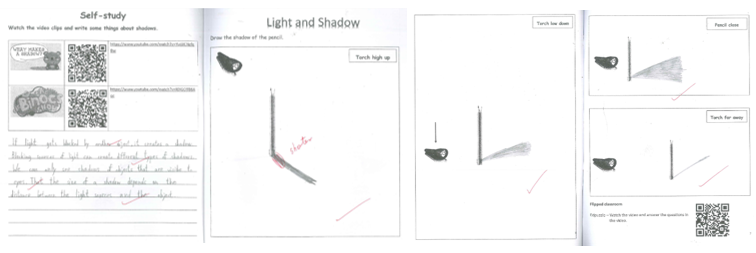
P5 students learnt more about the formation of shadow and they conducted hands-on experiments at home. Through “learning by doing”, students were encouraged to actively seek knowledge on their own, thereby preparing them to become curious lifelong learners.
Stage 4: Administering formative reading assessments and self-assessments to monitor students' learning progress
Formative reading assessments were administered after the teaching of each book to see if students succeeded in mastering different reading skills. Students were asked to read texts of similar themes and the questions were set for testing the target reading skills. Self-assessments were also included in the project to allow students to share feedback on the books they read. For example, they shared new words they learnt from the non-fiction books and expressed their likes and dislikes for different characters and the development of the story for the fiction books.
Students were engaged in reviewing and evaluating what they had read. |
Simple and focused formative reading assessments were administered to assess students’ learning of the target reading skills. |
Impact
Students
The knowledge gained from General Studies could be consolidated and extended through reading a variety of topic-related non-fiction books in English Language lessons.
Teachers chose non-fiction books for students to read so that they could learn content subject knowledge and language skills in English Language. Students were able to gain a deeper understanding of the General Studies topics through reading different English non-fiction books of the same themes. They were also able to use different language items and thinking skills they learnt in both subjects in different RaC activities such as making a water filter and doing research on the household items to apply their knowledge of the pulley system. The RaC project could help students establish meaningful links between concepts and ideas acquired in different subjects and their life experience.
Students learnt to make a water filter and tested its functions.
Positive values and attitudes were nurtured using a variety of fiction books which are thematically linked to the General Studies topics.
Teachers made good use of different value-laden fiction books to develop students' positive values and attitudes such as care for others and responsibility. The post-reading activities engaged students in reflecting on different life matters and motivated them to think about the right actions to take. Students were able to see different life events and the world from different perspectives, thus broadening their horizons. For example, through reading the story "Making Good Choice", the P5 students learnt about the risks of taking drugs, smoking and drinking. They created posters to encourage others to refrain from doing all these. The design of the "A balanced diet" project at P4 aimed at raising students' awareness of the importance of food labels, choosing healthy food items for themselves and others and becoming smart spenders. Students' critical thinking skills and positive values of caring for others were developed and nurtured.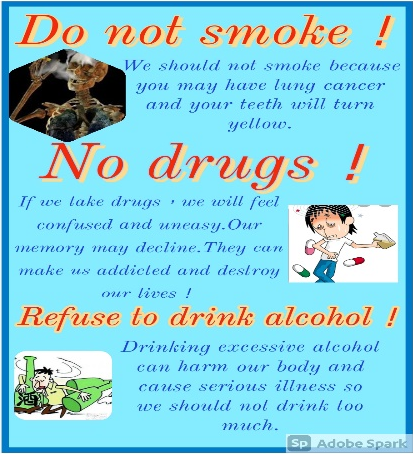
Students' reading interests and abilities were enhanced as they progressed from beginner readers to emergent readers.
With the use of a variety of text types, and both print and non-print materials carefully chosen for students in the curriculum mapping process, students' motivation to read was enhanced. They were given opportunities to read other materials online for independent reading. They could gradually put the reading skills such as making predictions, making connections and inferencing they learnt to use in order to "read to learn" and perform different self-directed learning tasks set for them.Students' generic skills and lifelong learning skills were enhanced through their participation in a variety of RaC activities.
Students were able to demonstrate their information technology skills, problem solving skills, self-management skills and study skills when doing the RaC activities during the pandemic. For example, students gathered information online to accomplish different post-reading RaC tasks and some had tried using different apps such as Flipgrid and Adobe Spark to produce posters or do oral presentations of their reading experiences.
Teachers
Teachers gained a broader view of the school curriculum.
Both language and content subject teachers could see more coherent links between subjects when they did curriculum mapping to align the themes of the two subjects for carrying out the RaC project. English Language teachers took the lead to make such connections across subjects whereas General Studies teachers realised that content and language learning could be integrated to create more coherent learning experiences for students.Teachers' competence and confidence in managing change were increased.
Due to the pandemic, teachers adopted the blended learning approach to implement the RaC project. Teachers had to use a face-to-face mode and an online mode to conduct different lessons and activities. Curriculum leaders were able to strengthen the collaborative culture of their team, in particular when the team had to work closely to resolve issues of implementing the RaC project during the suspension of face-to-face classes.Teachers' assessment literacy was enhanced.
Teachers included a variety of assessment modes in monitoring students' learning of the project. Simple online lesson tasks such as showing answers using the "remarks" and "chat box" functions in Zoom lessons, asking students to answer questions on Google Forms as a kind of summative assessment, having students make videos to share their understanding of different issues, administering competitions on Kahoot! or Quizziz were carried out in the lessons. The data gathered from the formative and summative assessments were analysed systematically to find out students' strengths and weaknesses so as to provide follow-up support.
Conclusion
Facilitating factors
Availability of funding
With the extra funding provided, human resources in the English panel were strengthened with an extra English Language teacher recruited. The curriculum leaders' teaching load was lessened and they could focus more on developing the school-based enhancement measures to further promote effective English learning and teaching.Teachers' readiness
The curriculum leaders were willing to change and they were ready to take on the challenge of implementing the RaC project though it was rather new to them. They were receptive to peers' input and comments.Strong leadership
The curriculum leaders in the English Department were able to take the lead in directing the whole RaC project. They were able to set clear goals and directions and plan concrete actions at different stages of the project. They were able to cope with difficulties and uncertainties when implementing the project. Their effective knowledge management enabled the project to operate successfully, in particular, during the pandemic.
Way forward
With the experience gained from implementing the RaC project for two years, teachers would like to further strengthen the cross-curricular collaboration between the English Language Department and other content subject departments to help students integrate language learning and content learning for increasing their exposure to English. Teachers will continue to explore the possibility of making a closer link between RaC and other Major Renewed Emphases such as STEM education, life-wide learning and Life Planning Education to broaden students' learning experiences.
Bibliography
Curriculum Development Council. (2014). Basic Education Curriculum Guide – To Sustain, Deepen and Focus on Learning to Learn (Primary 1 - 6). Hong Kong: Author.
Curriculum Development Council. (2017). English Language Education Key Learning Area Curriculum Guide (Primary 1 – Secondary 6). Hong Kong: Author.
Vacca, R. T. & Vacca, J. A. L. (2005). Content Area Reading: Literacy and Learning across the Curriculum. Boston, MA: Pearson/Allyn and Bacon.
CCC Mong Wong Far Yok Memorial Primary School
Amy FAN (Language Support Officer)
